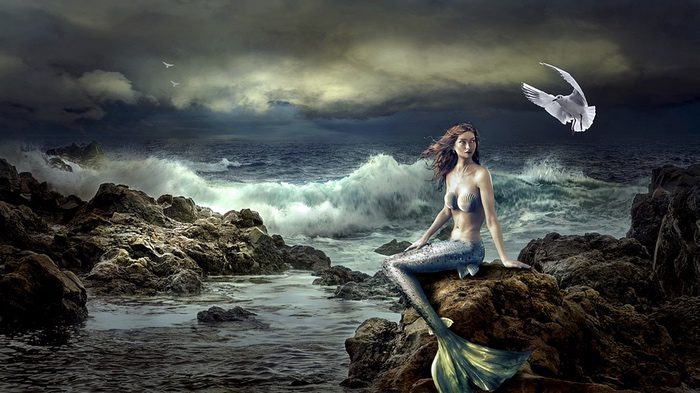 Mermaids and mermaid-like water spirits appear in the myths and stories of cultures around the world. In fact, they are so ubiquitous that it begs the question: “Are mermaids real?” In this guide, you’ll learn all about mermaids, mermen, and water spirits. Plus, you’ll learn about past and present-day mermaid sightings, which may make you question your own views about whether these creatures are myths or real…
Mermaids and mermaid-like water spirits appear in the myths and stories of cultures around the world. In fact, they are so ubiquitous that it begs the question: “Are mermaids real?” In this guide, you’ll learn all about mermaids, mermen, and water spirits. Plus, you’ll learn about past and present-day mermaid sightings, which may make you question your own views about whether these creatures are myths or real…
Table of Contents
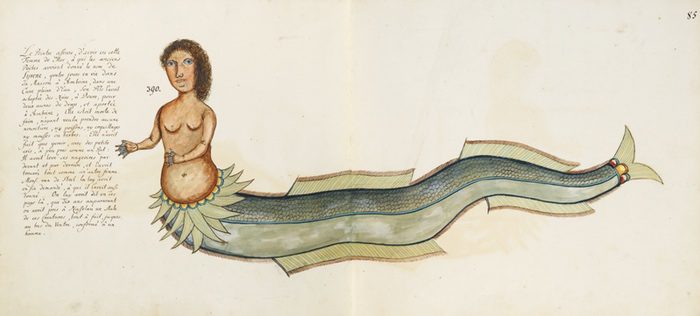
The answer to the question – What is a mermaid? – may seem obvious to some. However, once you begin to study the history and lore of mermaids, you’ll learn that the definition of a mermaid is not so easily defined.
For example, in popular culture, a mermaid is generally described as a beautiful woman with long, flowing hair who, from the waist-down, has the body of a fish. She lives in the ocean and can breathe underwater, occasionally making an appearance above the surface. She also happens to be a seductress who plays music and sings.
However, according to different legends, there are mermen too. Furthermore, not all mermaids are lovely and nice. In fact, some may be seductive at first, but then they become destructive, as in causing shipwrecks and turning people into slaves. Or, they can be downright monstrous, as in drowning people and eating them. We’ll explore both the lovely and malevolent mermaids in a bit. But first, the obvious question:
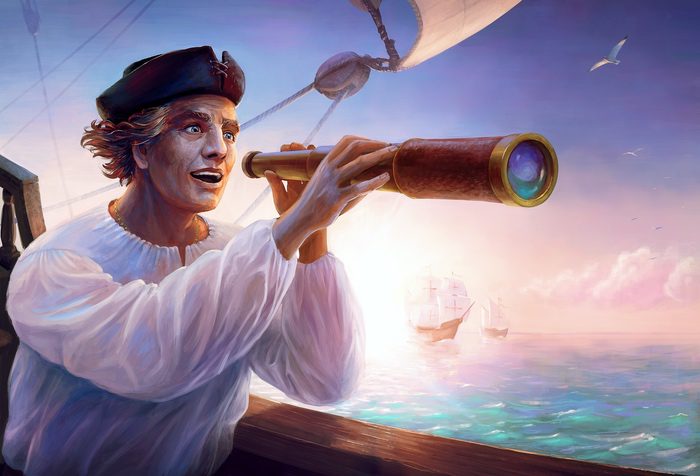
The answer to this question is a matter of opinion and timing. To ancient seafarers, mermaids were certainly very real. In fact, here are some documented cases of well-known historical figures who were convinced they saw mermaids:
In January 1493, Italian explorer Christopher Columbus wrote in his ship’s log:
“On the previous day [8 Jan 1493], when the Admiral went to the Rio del Oro [Haiti], he said he quite distinctly saw three mermaids, which rose well out of the sea; but they are not so beautiful as they are said to be, for their faces had some masculine traits.”1
Did the admiral of whom Columbus wrote actually see mermaids? Modern-day marine biologists theorize that what he saw were actually manatees or dugongs. However, we may never know for sure…
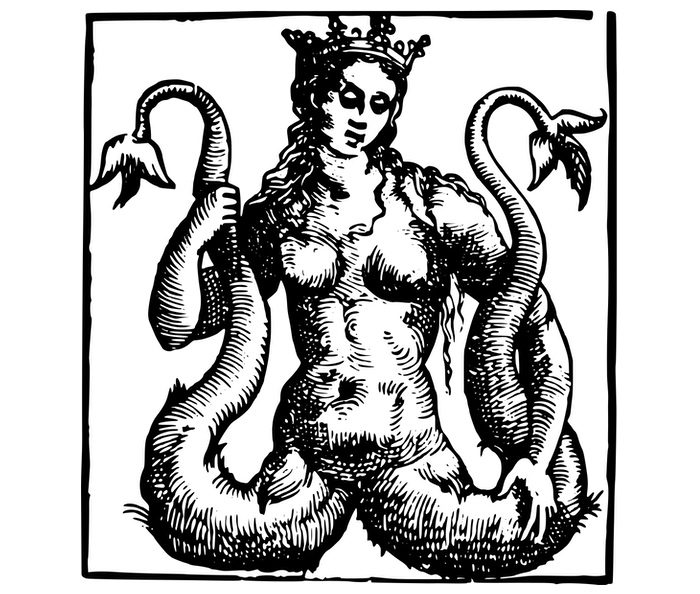
In November of the 1565, German Senator Christoph Fürer von Haimendorf of the Free Imperial City of Nuremberg in the Roman Empire wrote about seeing the skin of a mermaid while visiting Tura, Egypt on a pilgrimage to the Holy Land:
“In this Citie wee saw a Mermaids skinne taken there many yeares before, which in the lower parts ends Fish-fashion: of the vpper part, onely the Nauill and Breats remaine, the armes and head being lost.2
In 1608, English explorer Henry Hudson and his crew also reported in their ship’s logs that they had seen mermaids. One such sighting occurred off the coast of Norway, near the Lofoten archipelago. The explorers were searching for the elusive passage that could help British merchants reach Cathay (modern-day China) via a route above the Arctic Circle. Hudson (or his first mate) wrote:
“The fifteeiith, all day and night cleere sunshine ; the wind at east ; the latitude at noone 75 degrees, 7 minutes. We held westward by our account 13 leagues. In the afternoone the sea was asswaged ; and the wind being at east we set sayle, and stood south and by east, and south south-east as we could.
This morning, one of our companie looking over boord saw a mermaid, and calling up some of the companie to see her, one more came up, and by that time shee was come close to the ship’s side, looking earnestly on the men : a little after, a sea came and overturned her : from the navill upward, her backe and breasts were like a woman’s, as they say that saw her ; her body as big as one of us ; her skin very white ; and long haire hanging downe behinde, of colour blacke : in her going doAvne they saw her tayle, which was like the tayle of a porposse, and speckled like a macrell.’ Their names that saw her, were Thomas Hilles and llobcrt Rayner.”3
In 1610, the mariner, colonist, and writer Richard Whitbourne wrote about seeing a mermaid, as did his fellow sailors, in St. John’s Bay in Newfoundland. According to Whitbourne, the mermaid even tried to climb into several boats, terrifying Whitbourne and the crew. He wrote:
“Now also I will not omit to relate something of strange Creature, which I saw there in the yere 1610. in a morning early, as I was standing by the Riuer side, in the Harbor of Saint Iohns, which very swiftly came swimming towards me, looking cheerfully on my face, as it had bin a woman: by the face, eyes, nose, mouth, chin, ears, necke, and forehead, it seemed to be so beautiful, & in those parts so wel proportioned, hauving round about the head many blue streaks, resembling hair, but certainly it was no haire.
[The mermaid came] swifly toward me, where at I stepped backe; for it was come within the length of a long Pike, supposing it would haue spring aland to me, because I had often seene huge whales to…But when it saw that I went from it, it did theropon diue a little vnder water, & swam towards the place where a little before I landed.
Shortly thereafter, the mermaid swam up to a boat in the harbor and put both its hand vpon the side of the Boat, and did striue much to come int to him, and diuvers others then in the same Boat; where at they were afraid, and one of them strucke it a full blow on the head, whereby it fell off from them: and afterwards it came to other Boates in the said Harbour, where they lay by the shore: the men in them, for feare fled to land, and beheld it.”4

Other stories claim that the 17th century pirate Blackbeard, otherwise known as Edward Teach, wrote in his log that he wanted his crew to avoid sailing into certain waters because they were known to be “enchanted with merfolk.” However, proof of this journal entry has never been found.5
In addition, the 17th century explorer John Smith (whose life was saved by Pocahontas) supposedly saw and described mermaids. One quote says that Smith described mermaids this way:
“… swimming with all possible grace near the shore. The upper part of her body resembled that of a woman…she had large eyes, rather too round, a finely-shaped nose (a little too short), well-formed ears, rather too long…and her green hair imparted to her an original character by no means unattractive…[but] from below the waist the woman gave way to the fish.”
However, the John Smith story has been debunked. The first evidence of it appeared in an article written a couple of centuries later by Alexandre Dumas. (Dumas was the author of the classics The Three Musketeers and The Count of Monte Cristo.)6
While today, most people view mermaids as mythical creatures, there are still stories of mermaid sightings in recent history. You can read more about those in the section on modern-day mermaid sightings below. But first, let’s go back in time a little more to the first mermaids in recorded history…
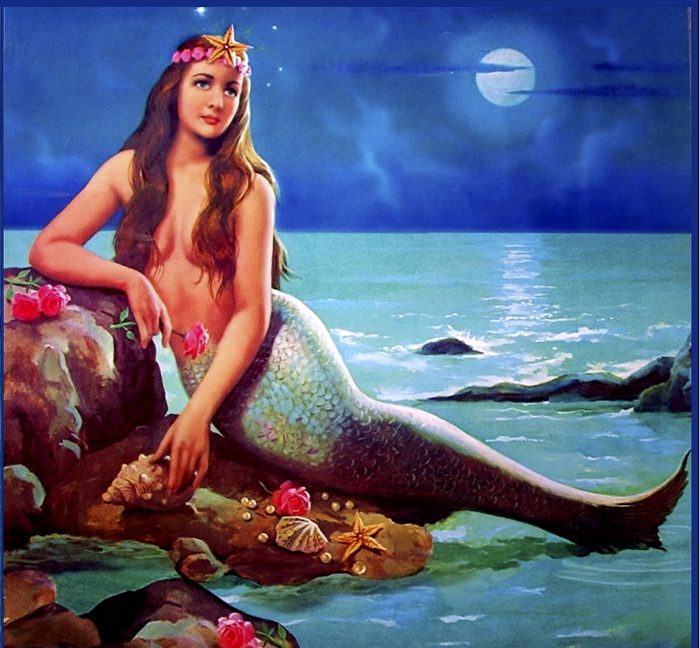
Mermaid-life creatures have appeared in the mythologies and folklore of cultures around the world for as long as we have had written history. And we can only assume that their stories go back much further than that.
Some anthropologists believe the origins of mermaid myths began with a foundational creation myth that many cultures around the world share. That is that the Earth was once covered in water, which we know scientifically to be true. Another creation myth shared by multiple cultures is that a great flood covered the world with water. Thus, people and other creatures having fish-like aspects may have originated with these myths.
The Mesopotamian cultures, which included the Sumerians, Assyrians, Akkadians, and Babylonians, wrote of deities who had mermaid-like qualities. Two of the most well-known were Oannes and Atargatis.
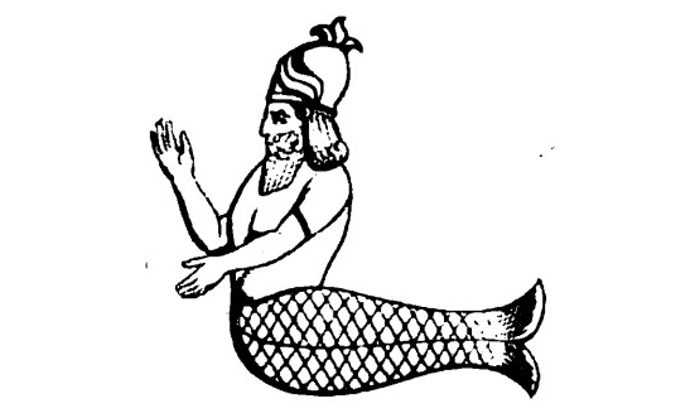
In the 3rd century BC, a Babylonian priest named Berossus wrote about a deity called Oannes. According to Berossus, Oannes was part-man and part-fish and he emerged from what is now the Persian Gulf.
Oannes was accompanied by the apkallu. The apkallu were demi-gods who were also semi-aquatic and described as part-human and part-fish. Both Oannes and the apkallu were the emissaries of the god Enki, who ruled water, wisdom, and creation.7 Because of this relationship, Oannes and the apkallu brought wisdom and the arts to the people.8
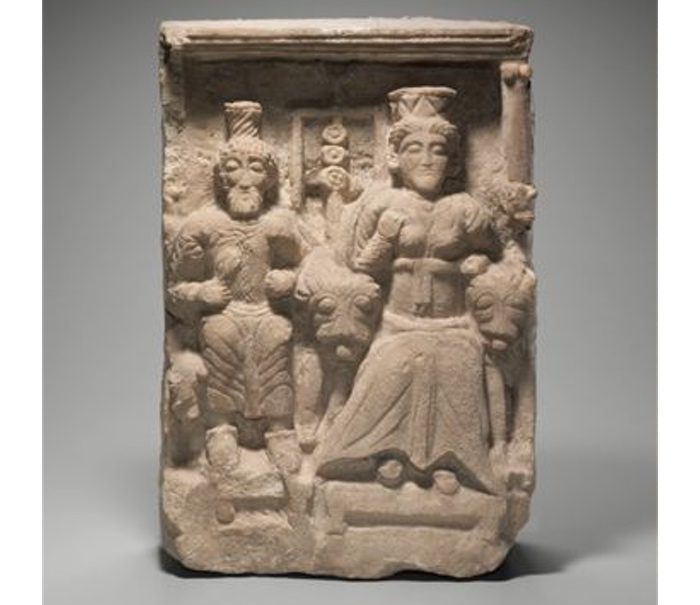
The ancient Assyrians had another deity who may have been the inspiration for future mermaids. According to the legend, the beautiful goddess Atargatis fell in love with a mortal man who was a shepherd. Unaware of the impact of her powers and beauty, Atargatis accidentally killed her lover.
Overcome with grief, she threw herself into a lake in hope she would die or at least turn into a fish. But her beauty was so powerful that only part of her became a fish and the rest of her maintained her human-like beauty.9
Atargatis came to be known as a goddess of fertility and love. And she was associated with both fish and doves.
By the 8th century, water spirits were still very much a part of Middle Eastern culture. In the tale “Jullanar of the Sea” in the book of stories 1,001 Arabian Nights, a childless sultan purchased a beautiful slave girl for his harem. However, she refused to talk and only looked wistfully out to sea.
Over time, the sultan earned her trust and she eventually became pregnant with his child. Once pregnant, she shared her story with him. She told him she was a creature of the sea and that she had been a princess who was raised in an underwater kingdom. However, a quarrel with her family drove her to leave the sea and climb onto land to seek refuge.
Jullanar and the sultan had a son and, like his father, he fell in love with a sea princess.10 There is far more to this tale, which involves a sorceress and fire worshippers, but we’ll leave that for another time…
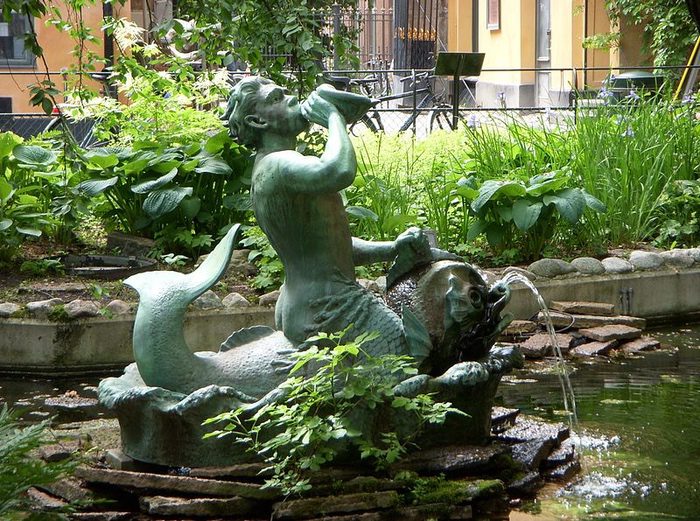
As a seafaring culture, the ancient Greeks had many stories about creatures who lived in the sea. To begin, they wrote of a goddess named Derketo who was most likely a manifestation of Atargatis. The Greeks described Derketo as having the head of a woman and the body of a fish.11
There were also the naiads, who were water nymphs. Inhabiting lakes, rivers, and streams, the naiads were beautiful, fun-loving, and benevolent.12 They were also known to live for a very long time, so they were sources of universal wisdom.
Perhaps one of the most famous mermen in history was the Greek god Triton. The son of the god of the sea, Poseidon, and his wife, Amphitrite, Triton was depicted as human from his waist up and fish from his waist down. Triton lived in a golden palace with his parents in the ocean’s depths. From there, he controlled the waves. In addition, he was very musical, blowing a conch shell13 like a trumpet.14
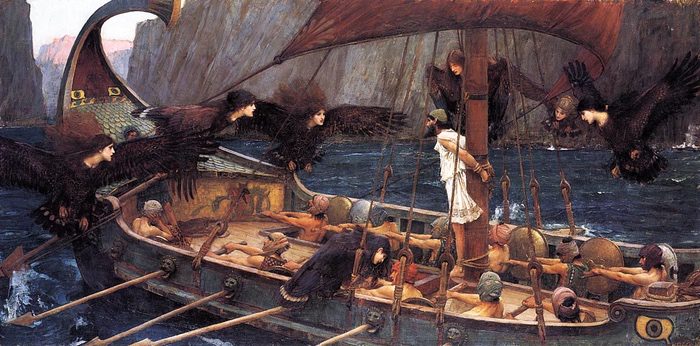
Probably the most well-known Greek water spirits were the sirens. Earlier myths described them as half-woman, half-bird. But eventually they came to be known as part-woman and part-fish.
The terms siren and mermaid are often used interchangeably because the two share many of the same qualities. Like mermaids, the sirens were well-known for their irresistible singing. In fact, their voices were so seductive that sailors became hypnotized when they heard them, even leaping off their ships to get closer to the enthralling sound.
In Homer’s epic poem the Odyssey, the hero Odysseus was journeying home after the Trojan War. Familiar with the sirens’ power, he ordered all of his men to plug up their ears with beeswax so they wouldn’t be hypnotized by their songs. Odysseus, however, did not want to deprive himself of listening to the sirens’ music, so he had his men tie him to the ship’s mast so that he could listen to their voices without jumping into the sea to find them.
While it’s unknown when mermaids also became known for their songs, many surmise it was the songs of the sirens that inspired that aspect of mermaid lore.
Greek mermaid legends may also have been inspired by scientific understanding of the times. The Greek philosopher Anaximander of Miletus, who lived from around 610 – 546 BC, theorized that human beings originated from fish. He believed that the only possible way that humans could have survived in the Earth’s climate was to start off with gills and scales.15
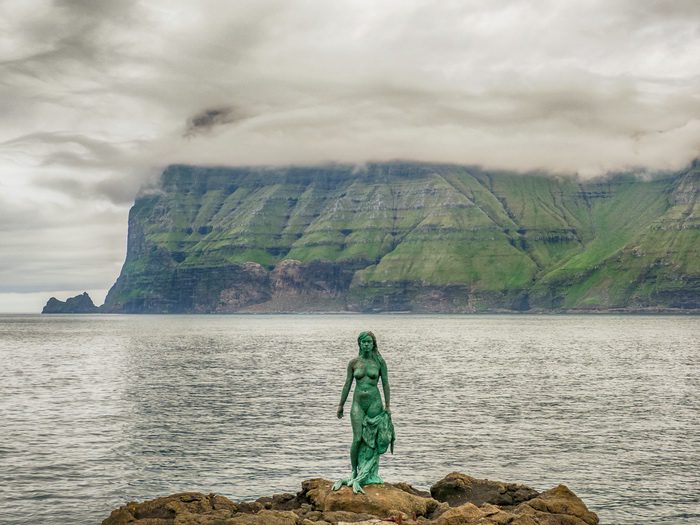
The Irish and Scots have long told stories about seal-like creatures who came to shore to enchant people. They described selkies as seals who could shapeshift into beautiful women. When they came to shore, they removed their fur and were transformed.
While selkies are not exactly mermaids, they do share some of their traits. To begin, they possess feminine wiles that are so seductive that they have the power to enchant and overwhelm men.
In many selkie tales, the man is so smitten with the selkie in her human form that he tries to convince her to remain on land with him. In some stories, he even uses underhanded means to trick her into staying, such as stealing her fur so that she can’t transform back into a seal and return to the sea. However, the man can never tame the selkie, as her heart eternally belongs to the sea.16
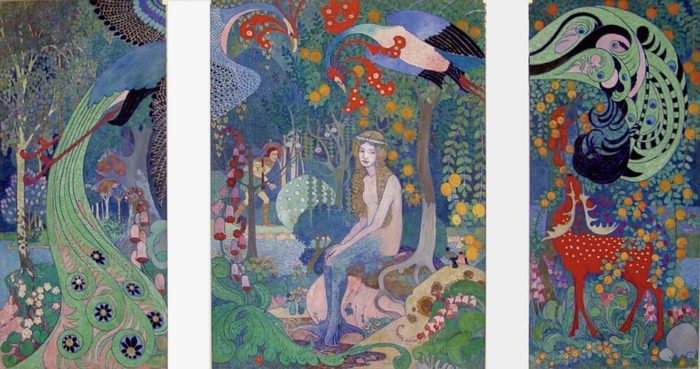
The French have a legend about a mermaid-like creature that dates back to the Middle Ages. Called the Melusine, she is a creature who resembles a mermaid, with a long fishtail. However, the Melusine prefers freshwater and can be found near rivers, lakes, and wells.17
According to the legend, the Melusine is the daughter of a fairy and a king. The fairy only agrees to marry the king if he takes an oath that he will never look at her or any of their children while they are bathing. As things go, the king breaks his oath, so the fairy escapes with her daughter Melusine to the isle of Avalon.
In the way that some believe mermaids were inspired by manatees or dolphins, the Melusine may have been inspired by the otter.
Like the Celts, the Vikings also told tales of selkies. According to some Nordic stories, the selkies were the souls of men who had drowned themselves.18
In addition, the Norse goddess Ran, the goddess of the sea, is associated with mermaids. However, Ran was not exactly benevolent. Her name is based on the Old Norse term for “plundering” or “theft,” and she was known to capture seafarers with her net.19

Pagan Slavs believed in benevolent water spirits whom they associated with fertility and abundance. Called rusalki, these friendly spirits emerged from lakes and riverways in the springtime and brought nourishing water to the crops.
Over the centuries, and depending on the region, the rusalki took on different descriptions and intentions. In some depictions, a rusalka was a beautiful maiden with flowing green hair. Often she was viewed as the reincarnation of a young woman who had drowned or killed herself. In some tales, the rusalka would tickle men to death. In others, she was a hideous monster who would kill men by forcing them to join her in a wild and deadly dance.20
While the Czech composer Antonín Dvořá based his famous opera Rusalka on the Slavic fairy tale The Little Mermaid, folklorists point out that rusalki are very different from mermaids, and that they are more similar to the Greek naiads.21
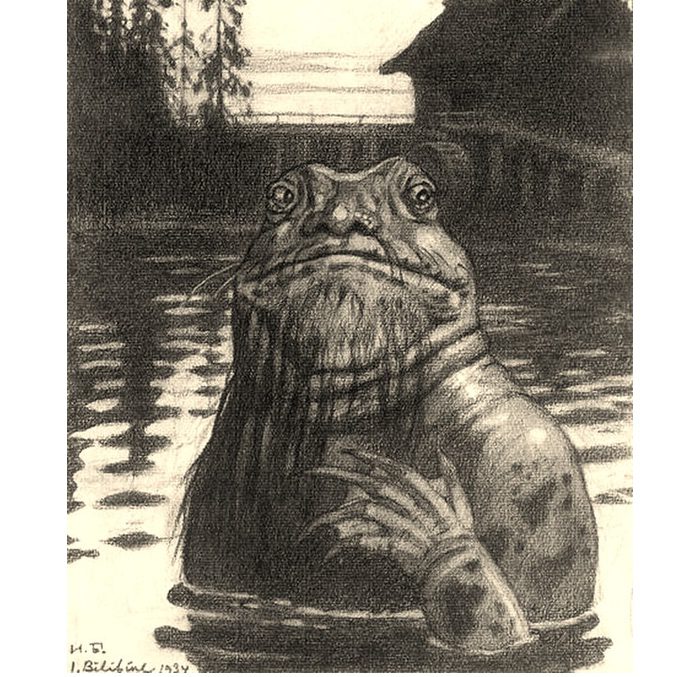
The Slavs wrote about another water spirit, a male, whom they called the vodyanoy. While he can’t fairly be described as a merman, he did somewhat resemble the modern-day Creature from the Black Lagoon. According to Slavic folklore, the vodyanoy had a frog-like face, long hair, a green beard, and webbed hands and feet. He also had a long fishtail. In addition, his body was slimy as it was covered in algae and muck.
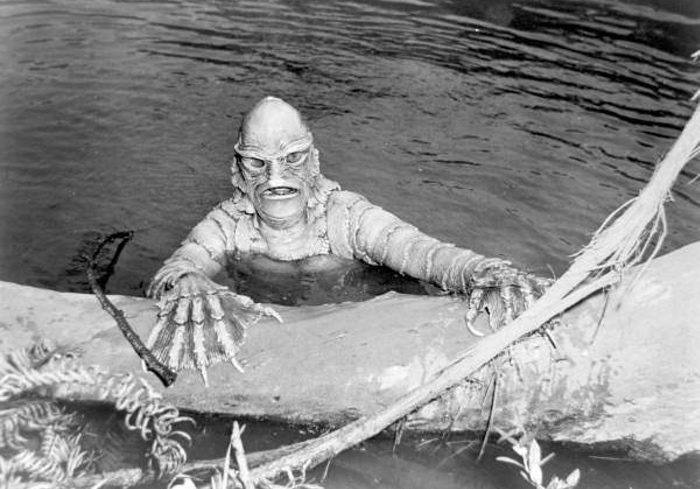
The vodyanoy was held responsible for loud splashes, broken dams and water mills, and people and animals drowning. Furthermore, the people whose bodies were never found were assumed to be used as slaves in the vodyanoy’s underwater dwelling.22
The ancient Egyptians are known for their many deities who were part-human and part-animal. By some accounts, the deities Isis and Osiris were depicted as part-human, part-fish, however, I have yet to find detailed evidence of this in my research.
The Egyptians did write about a female water spirit, or jinn, whom they called En-Naddaha, or “the caller.” According to Egyptian myths, she inhabited the waters of the Nile. Like a mermaid, she was hypnotically beautiful and seductive. She would sing or call to men who were walking along the Nile at night and lure them into the waters.23
The Egyptians told tales about another water spirit who was known in other parts of the African continent called Mami Wata.
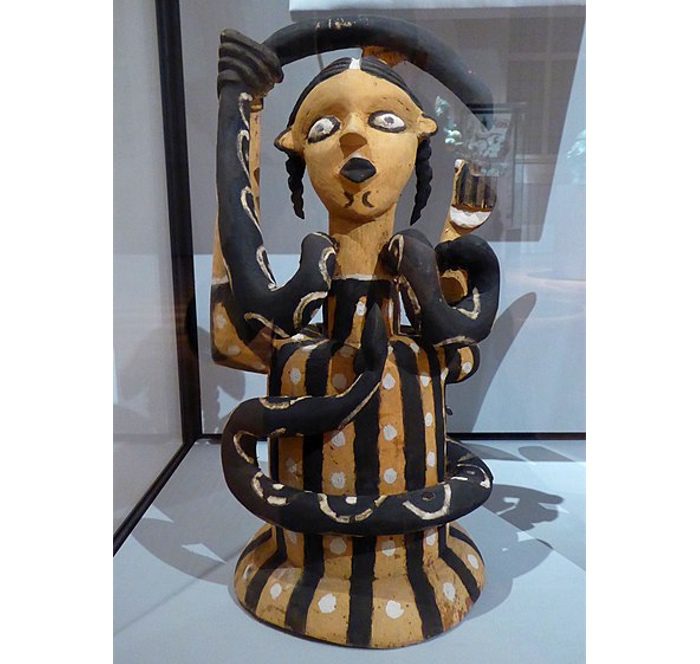
Dating back to at least 2000 BC, people in Africa told tales about a water spirit whom they called Mami Wata. A powerful entity, Mami Wata is depicted as having the upper body of a beautiful woman and the lower body of a fish or serpent. Anthropologists believe her name is derived from the Ethiopian word for truth and wisdom – mama – and the word for ocean water – uat-ur.
As the legend goes, like a sultry mermaid, Mami Wata would lure sailors into the water and out to sea. She didn’t drown them, however. Instead, she would keep them underwater in her sea kingdom and use them for her entertainment.24
Mermaid stories also pervade Chinese culture. In fact, the Chinese tell tales of a number of different types of mermaids. The 4th century BC text Shan-hai Ching, or Classic of Mountains and Seas, references a few of them.
The text chronicles both mermaids and mermen. Most commonly, they were described as having human heads and torsos with lower bodies of fish. However, some were described as having the upper bodies of fairies.25 Some made sounds like babies crying, while others were shapeshifters who could resurrect themselves if killed. Still others had little red wings. In addition, when some of them cried, their tears would turn into pearls.26
The Japanese version of a mermaid or merman, whom they call the Ningyo, varies a bit from western mermaids. While the Ningyo has the head of a human and the body of a large fish, they are also described as having the wide mouth of a monkey, sharp fangs, and horns on their head.
However, like the mermaid, the Ningyo has an enchanting voice. The Ningyo’s voice sounds like a beautiful flute, and it has the power to lure fishermen.
According to Japanese legends, the Ningyo was once a fisherman who was turned into a water-dwelling monster after sailing into forbidden, enchanted waters. A tragic creature, the Ningyo longs to revert back to life as a human being.27
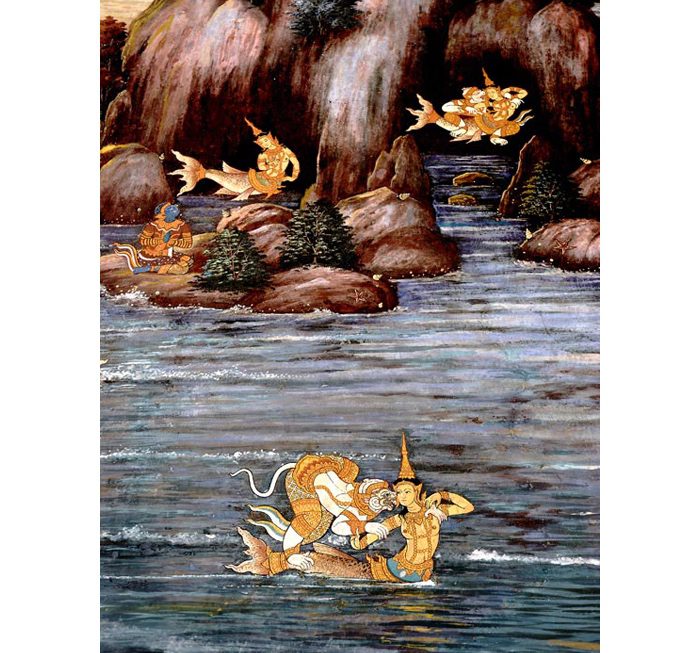
In Hinduism, the god Vishnu occasionally appears in the form of an avatar called Matsya. In this form, he looks like a merman, with the upper body of Vishnu and lower body of a fish.
Hindus (along with Buddhists and Jainists) also have myths about nagas and naginis (male and female), who are deities with human-like upper bodies and the lower bodies of serpents.
The purest mermaid in Hindu culture is found in the epic collection of stories the Ramayana. According to the myth, when the monkey god Hanuman attempted to build a bridge across the ocean during a rescue mission, he was stymied by mermaids. He and his warriors put rocks in the sea to build a bridge, but the mermaids removed them just as quickly.
So, Hanuman sought out the mermaids’ leader in an attempt to negotiate, so he could fulfill his purpose. The mermaids’ leader was a mermaid princess named Suvannamaccha. Smitten by her beauty, Hanuman soon fell in love with her. Realizing he could not withstand her spell, he began to woo her. She eventually fell in love with him in return.28 Hence, the mermaids were enlisted to help Hanuman in his cause.29
The Inuit of the Canadian Arctic tell stories of a sea spirit called the Qalupalik (or Qallupilluit.) According to the legend, the Qalupalik has long flowing hair and fins on its head and back. Its hands are webbed and clawed. In addition, it has a distinct smell that’s reminiscent of sulfur.
The Qalupalik has one human-like quality in that it carries an amautik on its back. (An amautik is a sack in which Inuit women carry their babies.) As the legend goes, if Intuit children wander too close to the shoreline, the Qalupalik might hypnotize them with its gaze, then snatch them and carry them underwater in its amautik.30
In Haiti, they call their mermaid La Sirène. She possesses enormous power, which, like Haitian voodoo, can be a source of good or evil magic. Like other mermaids, La Sirène is intoxicatingly beautiful and has an enchanting singing voice. In addition, she carries a magical mirror, which serves as a portal between the physical and mystical worlds. She can bring good luck to sailors. However, if she is not respected and treated with reverence, she will wreak havoc, sinking ships and even stealing babies.31
In Chilean mythology, the god of the sea has two beautiful daughters who are called La Pincoya32 and La Sirena Chilota.33 Both have long, flowing blond hair. While Pincoya is described as a water spirit, La Sirena is more like a traditional mermaid. Both daughters are known to be benevolent. King Millalobo has tasked them with caring for all fish. In addition, they are known to revive drowned sailors, swimming long distances to take them to safety. Furthermore, their tears have magical powers and the ability to cast spells.
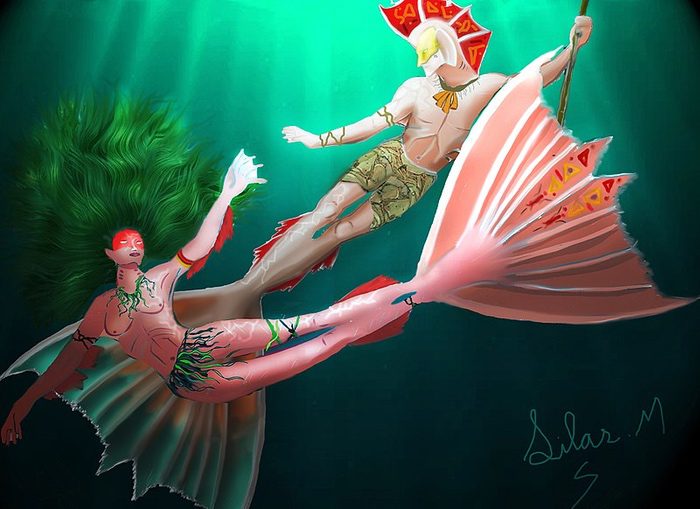
Brazilians tell the tale of a beautiful woman with long green hair and golden copper skin named Iara. According to the legend, Iara was a king’s daughter and beloved by her people. Not only was she beautiful, she was also multi-talented, particularly in the art of warfare.
While Iara was loved by her village, her two brothers were jealous of her skills. They were so envious, in fact, that they tried to kill her. However, the skilled warrioress fought them off, killing both. Although their deaths were in self-defense, Iara’s father was so incensed by the loss of his two sons that he had Iara thrown into a river and drowned.
Yet, even underwater, Iara was loved. Fish came to her rescue and used magic to revive her and turn her into one of their own – a mermaid.
Sadly, Iara never got over the betrayal of her brothers and father, so now she spends her days singing beautiful songs at the shoreline to lure men into the water where they will drown.34
The Aboriginal Australians tell tales of a creature who bears a striking similarity to the Intuit Qalupalik. The Muldjewangk is sometimes described as a bloodthirsty monster who lives in the deep and comes to the shore’s edge. At other times, the creature is described more like merfolk – only with more sinister intentions. Like Qalupalik, the Muldjewangk is especially fond of snatching children.
According to one tale, the Muldjewangk attacked a steamboat that carried European settlers. The boat’s captain allegedly saw two giant green hands with long nails grasp the hull of the boat. So, he grabbed his gun to shoot the creature. However, Aboriginal elders who were working on the boat warned him that the creature would not be easy to kill and that it would take loathsome revenge on him.
Nevertheless, the captain took his shots. Shortly after the incident, he broke out in a rash that turned into red blisters that covered his entire body, and he died a slow, agonizing death.35
The Maori People of New Zealand have a number of legends about whales and sea monsters, which they collectively call taniwha. One such creature is the Marakihau. In some versions, the Marakihau looks like a merman, with a human head and torso and a long fish tail. In other versions, the Marakihau is female. However, far from being seductive, the Marakihau is a creature to be feared as it has a forked tongue like a snake and is known to sink canoes and other boats.36
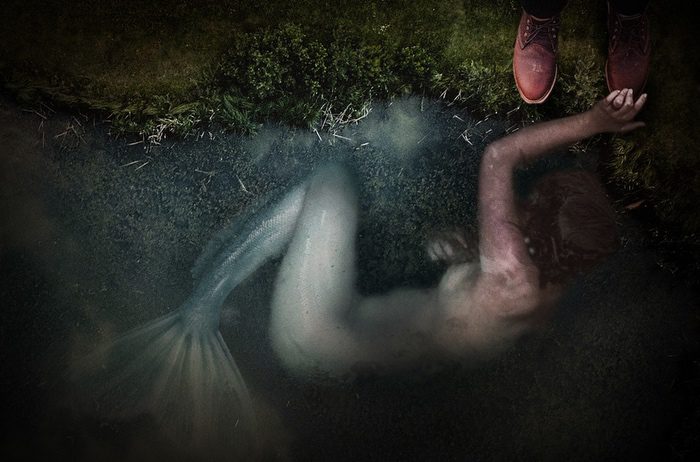
While today most people view mermaids as mythical creatures, this hasn’t stopped some from reporting sightings of mermaid-like creatures.
During WWII, multiple Japanese soldiers stationed in the Kei Islands of Indonesia reported seeing a mermaid-like creature. Yet instead of praising the creature for its beauty, the sailors described it as a “horrible monkey-thing with a fish mouth and spines like a sea urchin.” With inward-facing teeth and a mouth like a carp, the creature was also described as having two long arms, webbed hands and feet, and frog-like legs.
The local Kei islanders were well-aware of the creatures. They called them Orang Ikan, which translates from Malay to “human fish.” Occasionally, local fishermen would catch the creatures in their nets. However, as the Orang Ikan were aggressive, the islanders did their best to leave them alone.
One evening, the king of the village summoned one of the leaders among the Japanese soldiers, Sergeant Taro Horiba. The villagers had discovered a dead Orang Ikan, which they wanted him to see. Sergeant Horiba reported back to his headquarters in Japan that he did indeed see the strange creature. He even urged zoologists to study it after the war. However, reportedly no one took him seriously.37
The people of South Africa have a long history of mermaid sightings, which date back thousands of years. To begin, archaeologists have discovered a number of sights in South Africa where ancient petroglyphs depict creatures who are half-human and half-fish.
Yet as recently as 2008, locals reported mermaid sightings in the Buffeljags River in a village called Suurbraak in Western Cape Province.
The sighting occurred while some locals were hanging out on the riverbank. They reported hearing a loud banging noise. Thinking it might be vandals, a man named Daniel Cupido and his friends went to get a closer look. Daniel reported seeing a figure whom he described as “a white woman with long black hair thrashing about in the water.”
Thinking he needed to rescue her, Daniel moved quickly towards the water. But as he got closer, he was taken aback by the woman’s inhuman reddish eyes, which he said sent shivers down his spine. But as repelled as he was by the sight, he said he felt a hypnotic pull towards the creature. So, he yelled to his family and friends to help him.
Daniel’s friend Martin Olckers said he also saw the creature and that it looked strangely female. Martin said the creature was making a strange, sorrowful sound. Martin’s mother, Dina, was also present. She confirmed that she heard the crying and that it was so heart-wrenching that her “heart could take it no more.” The creature dove into the water and was gone. Similar sightings had been reported by locals in the area 15 and 20 years prior.38
Over the past couple of decades, people in Alaska have reported sightings of merfolk-like creatures in the sea.
In a vast wilderness area that’s known as the Alaska Triangle, a staggering 5 in 1,000 people go missing every year. Part of the triangle covers the Gulf of Alaska. In one case, two men were fishing when one caught something big. As he tried to lure it in, he was pulled into the water. His friend described seeing a creature similar to the Inuit legend of the Qalupalik. He said he saw a green webbed hand and that the creature yanked his friend overboard. As he rushed to help him, he said he was taken aback when the creature turned and had a tail like a dolphin’s. His friend was never found.
A couple on Kodiak island described seeing a similar creature. The man was swimming in the waves as his girlfriend read a book on the shore. Suddenly, the man said, something underwater grabbed his ankle and pulled him down. Seeing him thrashing in the waves, his girlfriend ran towards the water. She says she saw a green foot and tail, then the creature disappeared. Once she helped her boyfriend to the shore, she described what she saw, and he affirmed he saw the same thing.39

Just as they did centuries ago, mermaids continue to mesmerize people of diverse cultural backgrounds today. While their stories are intriguing enough, it’s also a matter of what mermaids mean to us personally. Here are some mermaid meanings and symbols and what they could mean in your life:
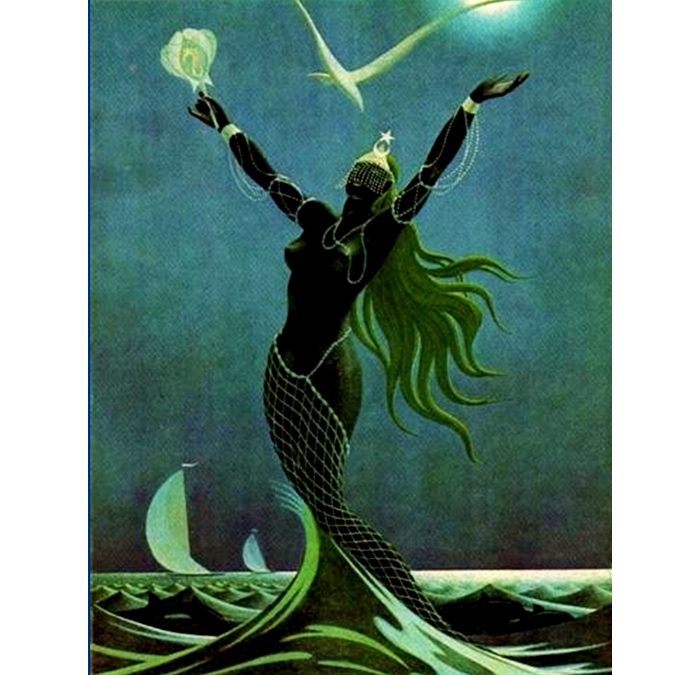
While some mermaids and water spirits are portrayed as monstrous, the more commonly shared impression is that they’re irresistibly beautiful. In this respect, they embody a type of physical power and sensuality. Furthermore, mermaids exemplify natural beauty over artifice. While we land-dwellers plod along, fighting gravity, the mermaid flows effortless and gracefully beneath the surface of the ocean. In essence, the mermaid is beauty in a state of flow.
The mermaid reminds us that we are most beautiful when we are in our element. When this happens, the inner radiance of our spirit shines forth – and that is beauty in its finest form.
Your element may be caring for others, performing, walking dogs, organizing, racing, teaching, or something else. The key is to know what it is. If life doesn’t feel beautiful to you, the mermaid reminds you that it’s worth putting in the effort to find your flow. Once you do, you will know it. It will feel as graceful and beautiful as a mermaid floating along a gentle current under the sea.
Mermaids also symbolize the power of music. Rhythm, harmonies, lyrics, and all that music embodies has the power to heal us, energize us, and lead us down pathways of transformative emotion. The mermaid reminds you to fill your life with music and to even consider broadening your musical horizons.
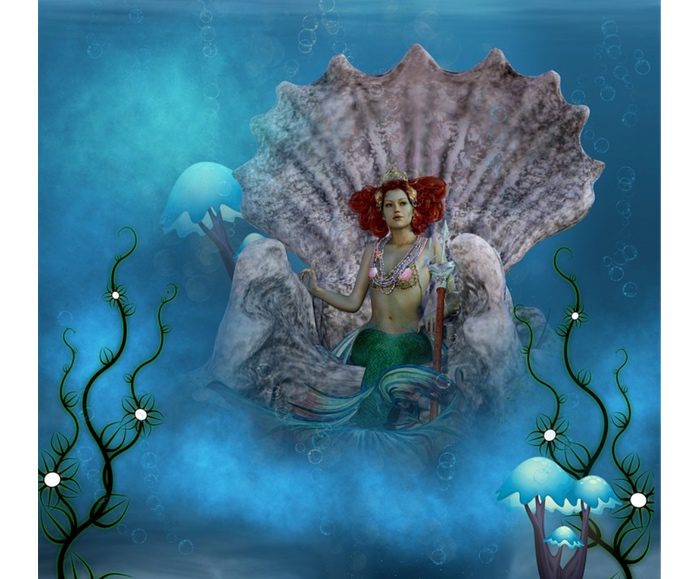
Across cultures, an attribute that mermaids possess is the power of seduction. And with this seduction there is an element of escapism – of allowing our feelings and senses to overwhelm us and carry us away from reality. This attraction can be tantalizing and even transformative or catastrophically dangerous. As a symbol of seductiveness and escapism, the mermaid challenges us to ask ourselves why we want what we want.
People, experiences, and things all stimulate us in some way. Thus, it’s worth considering why we are seeking such stimulation from a given source. On the one hand, the mermaid entices us, telling us to give in and go with the flow. On the other hand, her dangerous aspects challenge us to ask ourselves if the given stimuli will truly fulfill us or if it’s merely an illusion that could take our breath away and keep us from something more meaningful and profound.
One of the most intriguing aspects of mermaids is their elusiveness. The mermaid doesn’t like to be pinned down or confined. The mermaid may allow a brief glimpse, but then she disappears under the ocean’s depths. The viewer is left to wonder if they really saw what they think they saw.
As a symbol of elusiveness, the mermaid reminds us to not let ourselves be confined by constructs imposed by people or situations that don’t serve our best interests. Instead, we should surround ourselves with people who value our freedom and independence, and who respect our need to be in flow.
In addition, the mermaid reminds us to not be too available in ways that let others take advantage of us. Boundaries are important, and scarcity can drive demand. Thus in professional, romantic, or other types of relationships, a level of elusiveness can make people appreciate all that we have to offer even more.
As mermaids, mermen, and other water spirits have intrigued people around the world for thousands of years, they remind us of the magical power of our imaginations. Perhaps ancient seafarers really did see some kind of part-human, part-fish creature, now extinct. Or perhaps what they saw were dolphins, manatees, or other animals frolicking in the waves from a distance. What is clear is that mermaids and other water spirits are only as beautiful or horrific as our imaginations allow them to be.
As a symbol of the power of our imagination, the mermaid reminds us to tap into its depths. As children our imaginations are easily accessible and vivid. Yet as adults, we focus more on real-world responsibilities and actions.
If a mermaid makes themselves known to you in a way that rivets your attention, whether in a film, artwork, or some other setting, it can be a sign that you should tap the magical spring of your imagination a little more.
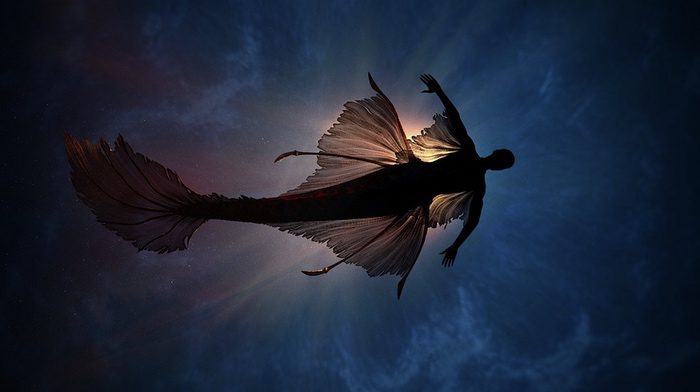
The earliest mermaid myths appear to be based on a scientific fact that all life on Earth originated in the water. Then, as land masses began to rise above the water’s surface, some creatures evolved to move on land, while others remained in the sea. Still others moved back and forth between the two elements.
Marine mammals, such as manatees, whales, and dolphins, evolved to remain in the sea while still breathing oxygen. Seals, otters, turtles, frogs, and alligators evolved to spend part of their time on land and part in the water. Because these animals evolved to move between these two elements, they symbolize evolution and transformation – as does the mermaid.
On a symbolic level, going into water represents diving into your subconscious or even your super-conscious. It symbolizes an altered state from your day-to-day existence in the material world. Yet, as the mermaid does, the ability to move back and forth between the two worlds gives you a kind of magic. It enables you to tap into Universal Wisdom and transform an area of your life in the material world.
After all, this is what manifesting is all about. Who you want to be, where you want to go, and what you want to create all originate in your imagination. And connecting with the benevolent forces that exist beyond the material world can help you to manifest what you want to create. The mermaid reminds you that you have within you the power to transform your life and the world you live in.
UniGuide is dedicated to nature and animal lovers, spiritual seekers, and mythology fans.
©2025 UniGuide Media LLC
All Rights Reserved.
UniGuide participates in affiliate programs in which I may earn a small commission if you buy products you link to from UniGuide. Please see my Disclosures for details.
I donate 10% of UniGuide’s profits to animal welfare, wildlife conservation, and environmental charities. Learn more on About UniGuide.
UniGuide Media LLC
Sausalito, CA 94965
| Cookie | Duration | Description |
|---|---|---|
| cookielawinfo-checkbox-analytics | 11 months | This cookie is set by GDPR Cookie Consent plugin. The cookie is used to store the user consent for the cookies in the category "Analytics". |
| cookielawinfo-checkbox-functional | 11 months | The cookie is set by GDPR cookie consent to record the user consent for the cookies in the category "Functional". |
| cookielawinfo-checkbox-necessary | 11 months | This cookie is set by GDPR Cookie Consent plugin. The cookies is used to store the user consent for the cookies in the category "Necessary". |
| cookielawinfo-checkbox-others | 11 months | This cookie is set by GDPR Cookie Consent plugin. The cookie is used to store the user consent for the cookies in the category "Other. |
| cookielawinfo-checkbox-performance | 11 months | This cookie is set by GDPR Cookie Consent plugin. The cookie is used to store the user consent for the cookies in the category "Performance". |
| viewed_cookie_policy | 11 months | The cookie is set by the GDPR Cookie Consent plugin and is used to store whether or not user has consented to the use of cookies. It does not store any personal data. |